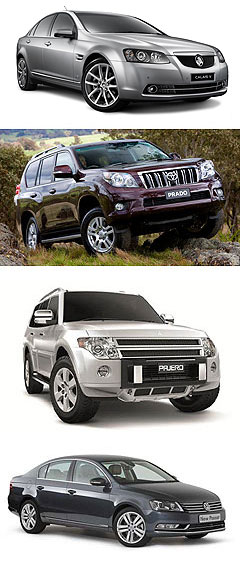Make / Model Search
News - General News - Regulation“Absurd” luxury car tax under fireOn the threshold: FCAI chief Ian Chalmers said the LCT now applies to almost five times as many new-vehicle sales as when it was first introduced. FCAI and AAA call for abolition of LCT at Canberra tax summit10 Oct 2011 WHILE the automotive attention at last week’s tax forum in Canberra centred on proposals for a congestion tax in our capital cities, motoring bodies took the opportunity to reapply the blowtorch to the government on the subject of the much-hated luxury car tax (LCT). The former head of treasury and author of last year’s Henry Report on the future of the Australian tax system, Ken Henry, told the summit the LCT was “truly absurd”. Speaking in the presence of prime minister Julia Gillard and treasurer Wayne Swan, the chief executive of the Federal Chamber of Automotive Industries (FCAI) Ian Chalmers told the forum that the LCT was increasingly a tax on regular Australians than a tax on luxury. Mr Chalmers said the LCT now applied to 14 per cent of new vehicles sold, whereas it impacted on just 2.9 per cent of sales when introduced. And the lack of indexation has seen the threshold rise only 3.6 per cent in the past decade to about $57,466, whereas the rise in average weekly earnings should have pushed the threshold out to something like $85,000. His predecessor at the FCAI, Andrew McKellar, who is now the chief executive of the Australian Automobile Association – whose members include the NRMA, RACV and RACQ motorist groups – told GoAuto the AAA agreed the luxury car tax should be abolished. “Our view is that it is a poorly designed and unnecessary tax,” Mr McKellar told us. “It was not talked about a lot at the tax forum, but it should be on the reform agenda. We don’t see any point in retaining it.”  From top: Holden Calais V-Series, Toyota Prado, Mitsubishi Pajero, Volkswagen Passat V6 4Motion. From top: Holden Calais V-Series, Toyota Prado, Mitsubishi Pajero, Volkswagen Passat V6 4Motion.Mr McKellar said the AAA was looking for a better deal for heavily taxed motorists and has also proposed abolishing fuel excise and state imposts on new cars such as stamp duty and registration fees, saying they were “being short-changed”. At the least, the AAA wants the government to direct more of the $13.5 billion in petrol and diesel fuel excise it will raise in 2011-12 to be spent on roads and other transport infrastructure. The LCT hit the headlines in 1990 when then-treasurer Paul Keating announced it as a 50 per cent addition to the wholesale tax – causing Mercedes-Benz to launch a “stripper” 180E model to get under the threshold– only to reduce it a year or two later. In 2000, when wholesale tax was abolished as part of the GST introduction, the Howard government made the LCT 25 per cent on the retail price. That was increased to 33 per cent in 2008 by the Rudd government, with a higher threshold ($75,000) for cars with average fuel consumption of 7.0 litres per 100km or better. Mr Chalmers told the Canberra forum that the luxury tax was “increasingly being served up to the unwitting common man”. “In reality, the luxury car tax is a tax on the introduction of advanced safety and environmental features in the Australian motor vehicle market,” the FCAI CEO told the forum. “The incidence of the luxury car tax is growing rapidly. The proportion of new vehicles exceeding the luxury car tax threshold grew from 2.9 per cent in 1979 (when a luxury tax was first introduced) to 14 per cent in 2010. “In consequence, the luxury car tax now applies to many popular family vehicles as well as vehicles commonly relied upon by people living in rural and regional areas of Australia. “For example, the luxury car tax is payable now on the purchase of Holden Commodore and Ford Falcon variants. You pay it on a Toyota Land Cruiser and Prado, Mitsubishi Pajero will cop the luxury car tax, as does the Land Rover Discovery and the Lexus 250 just to name a few.” Mr Chalmers said that, although the LCT was indexed annually, it excluded the price of many new features such as electronic fuel injection, ABS brakes, electronic stability control and on-board climate control. “Therefore, in reality the luxury car tax threshold bears little relevance to actual movements in new car prices over the 11 years since this tax was introduced,” he said. “The luxury car tax threshold has barely increased over the past decade from just over $55,000 ten years ago to $60,000 [actually $57,466] now. That’s a 3.6 per cent increase … in over 11 years. “By contrast, had the luxury car tax threshold been indexed to, say, average weekly earnings – the rate that most people base their capacity to afford a new car – over a similar period, the tax would now only be payable on vehicles selling for around $85,000. “The luxury car tax should be abolished. This was recommended in the Henry Review. “At the very least, if you won’t abolish it, Treasurer, please think about it. It should be redesigned to encourage reduced CO2 emissions from genuine luxury vehicles, not the sort of car that the average person wants to buy.”  Read more |
Click to shareGeneral News articlesResearch General News Motor industry news |










Facebook Twitter Instagram